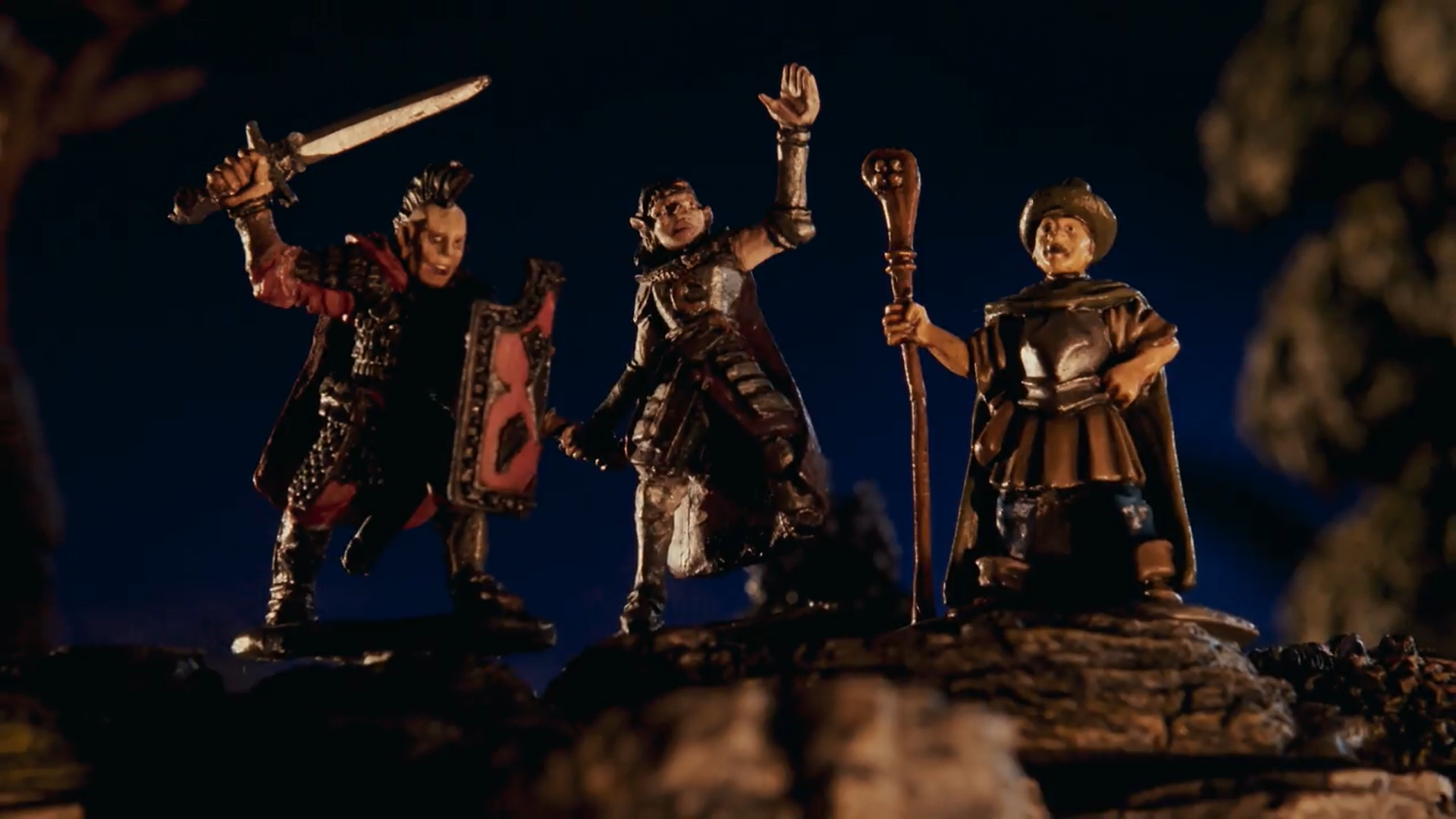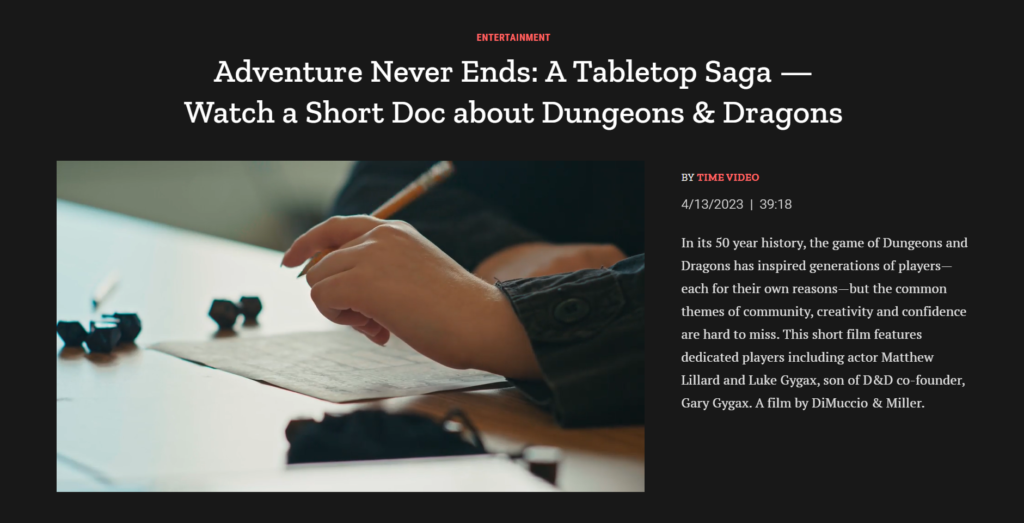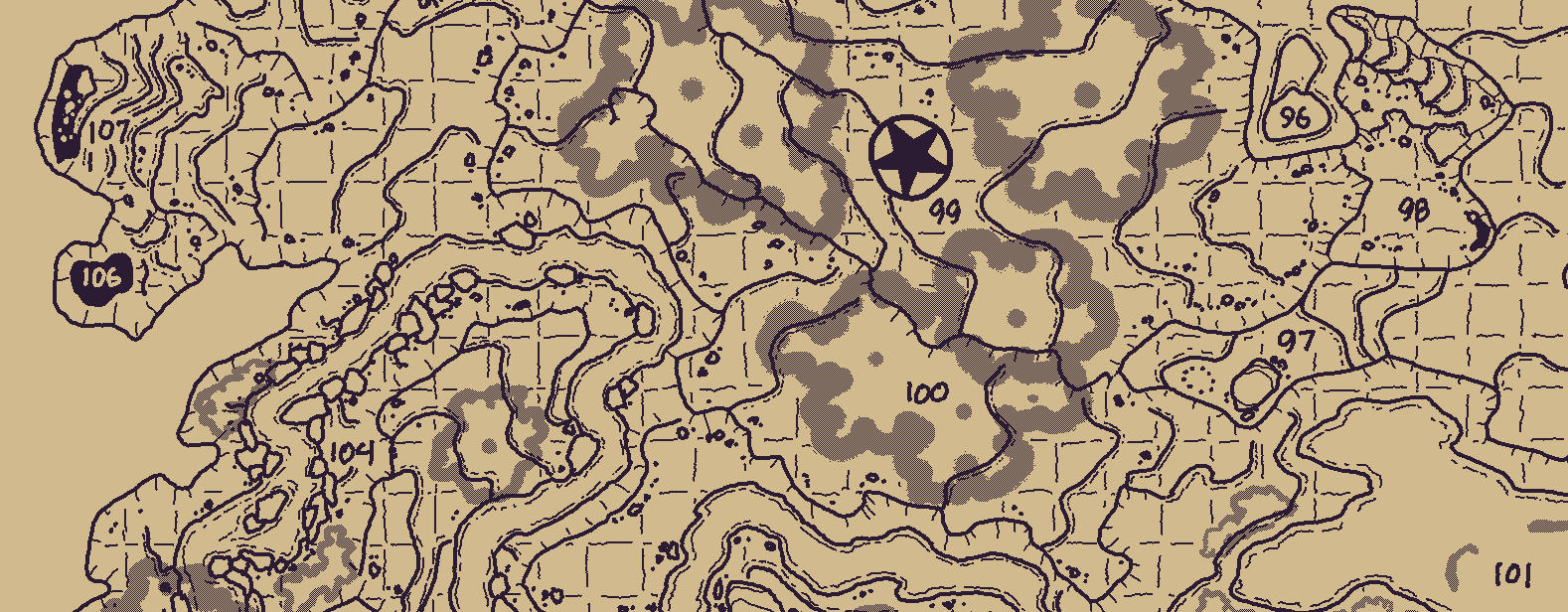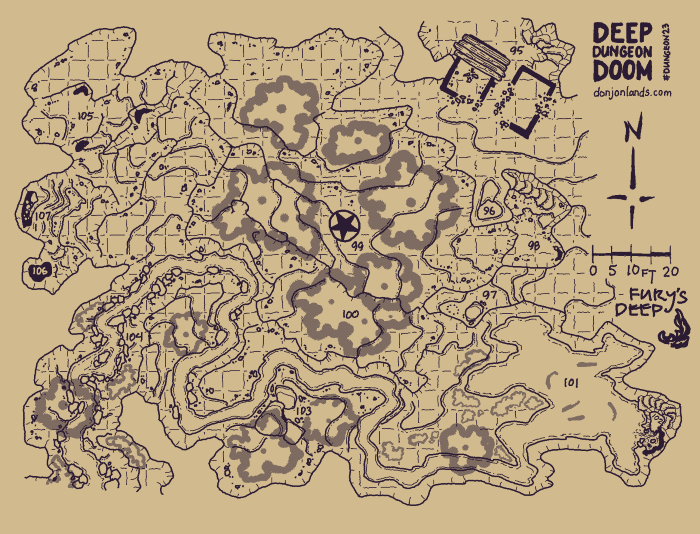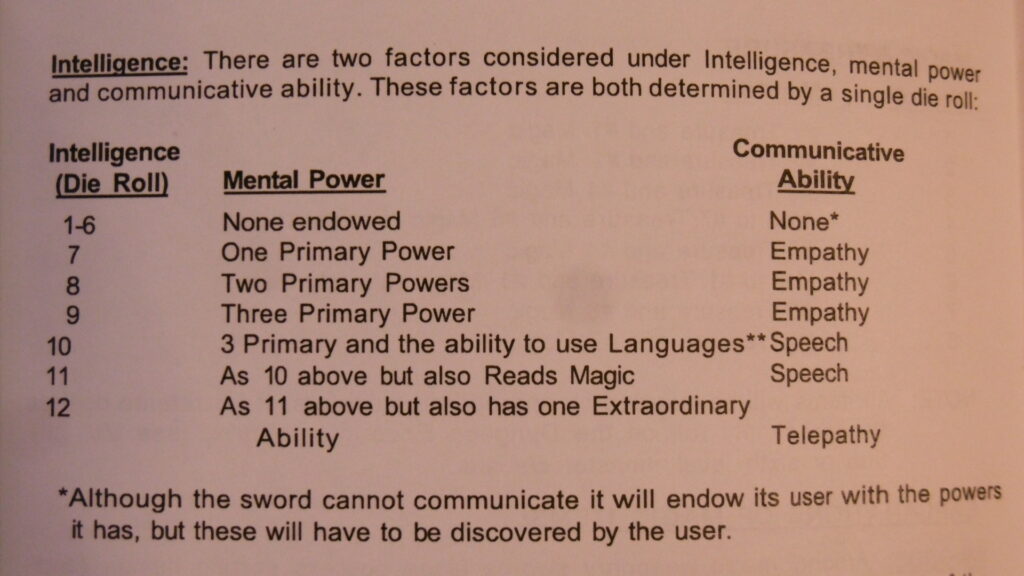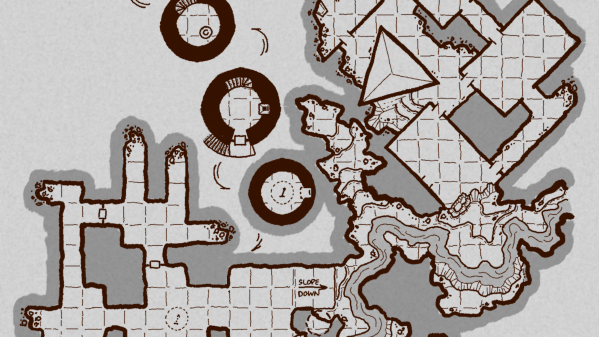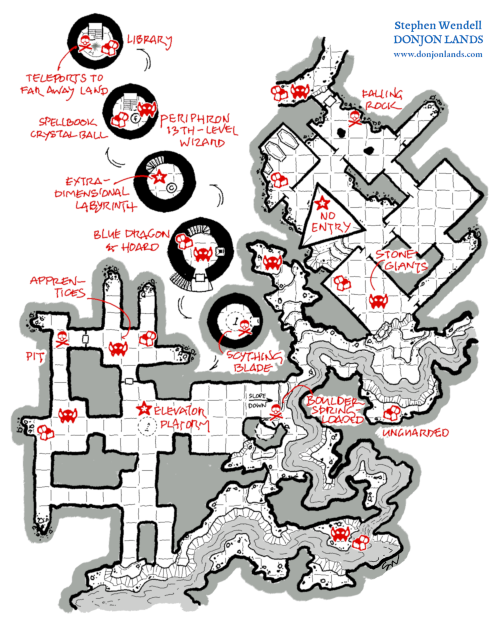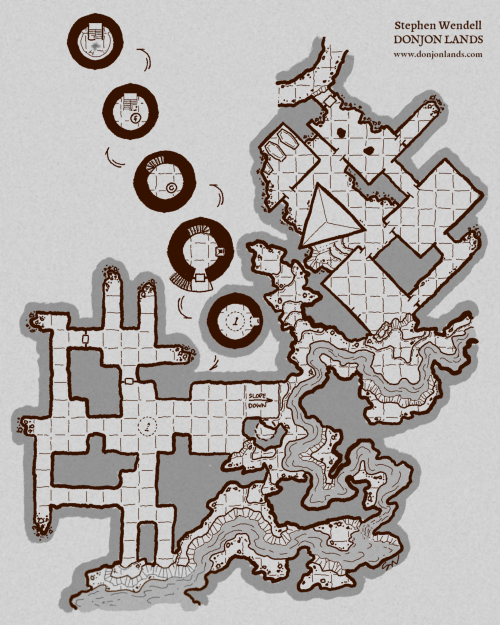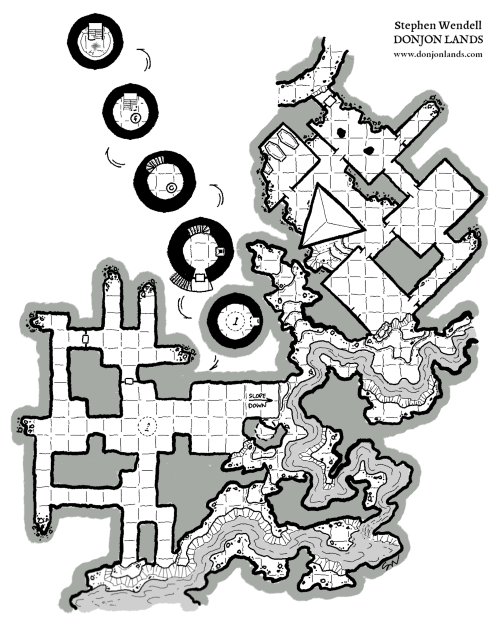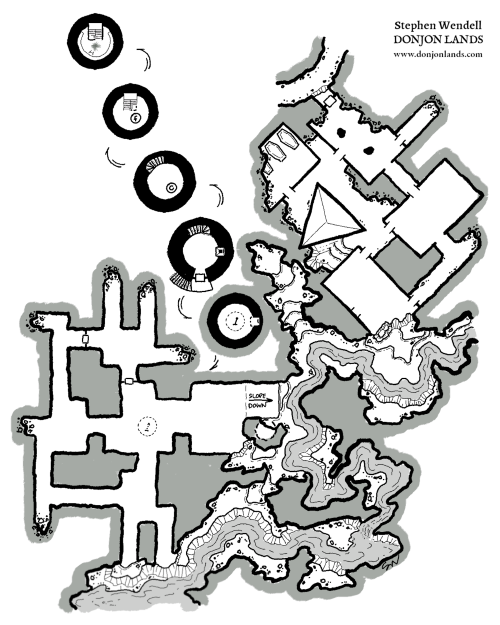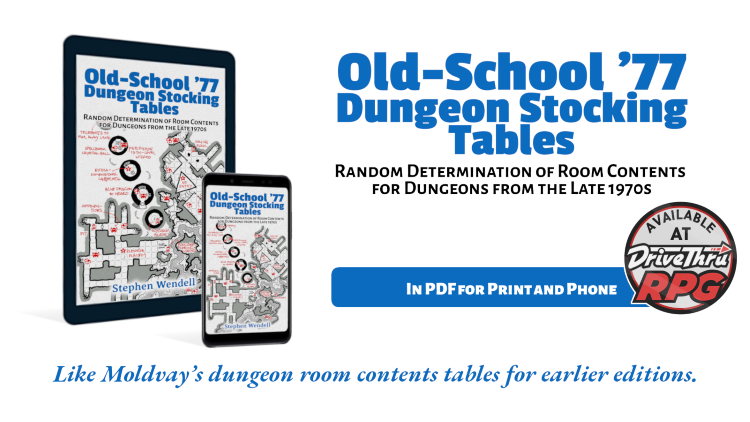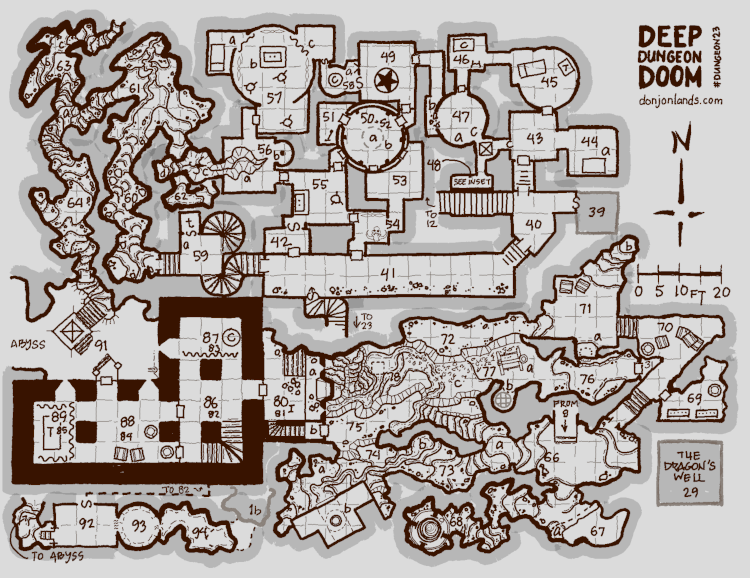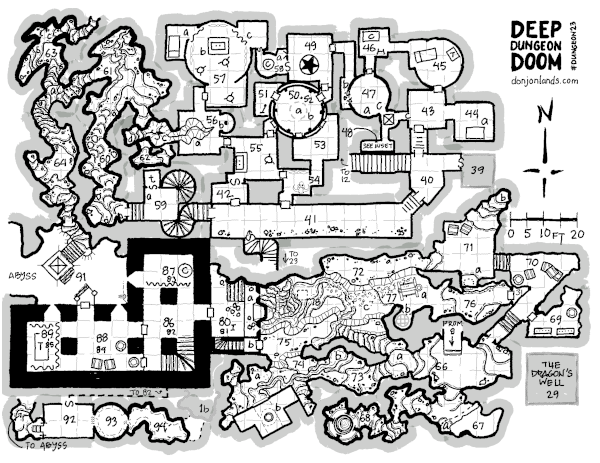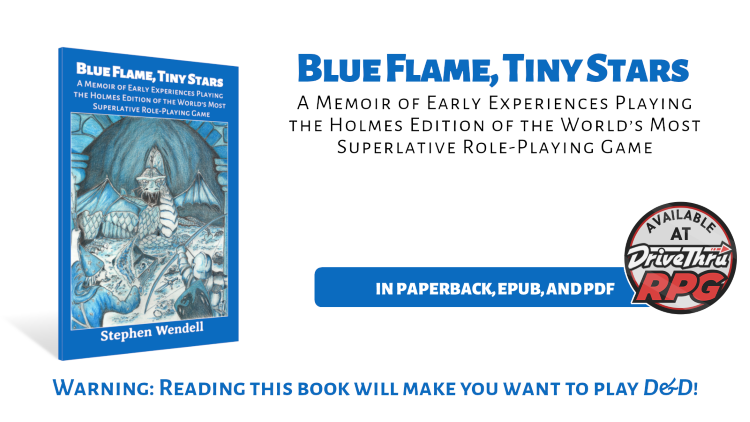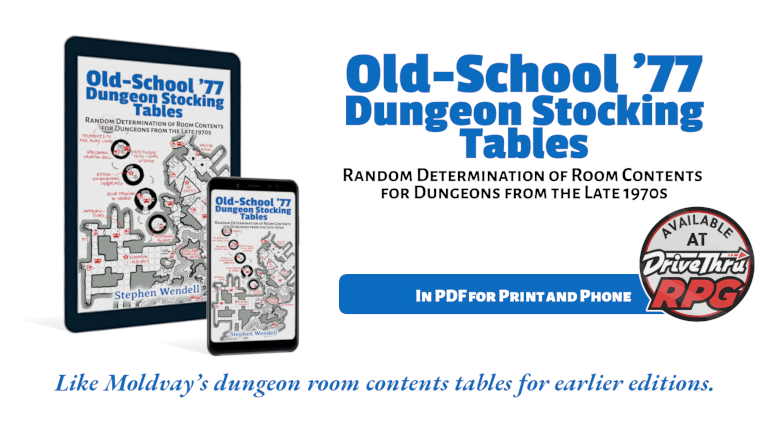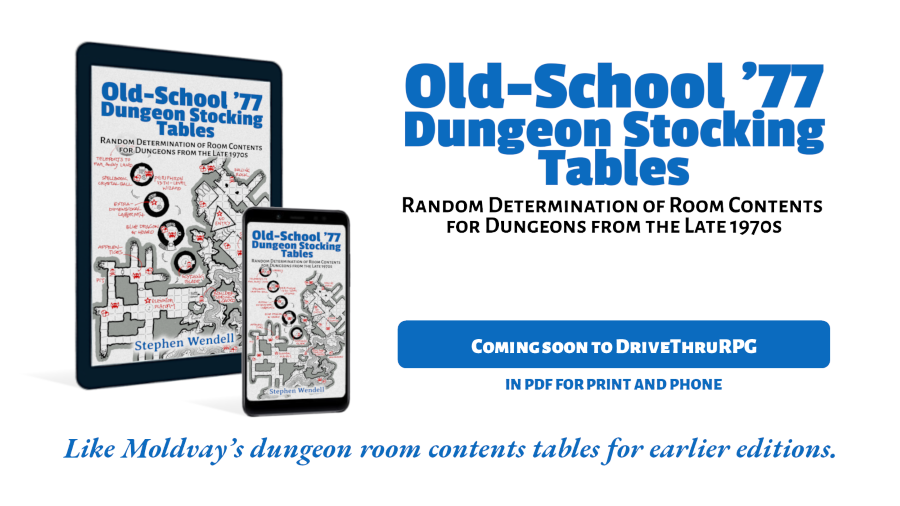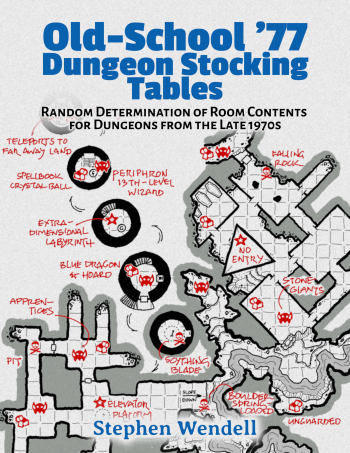Level Advancement
This is the 22nd in a continuing series of articles, which reedits house rules for Holmes Basic D&D from 40-year-old game club newsletters. Mentions of house rules are in bold text and followed by a [bracketed category designator].
For rules category descriptions and more about the newsletters, see “About the Reedition of Phenster’s.” For an index of articles, see Coming Up in “Pandemonium Society House Rules.”
Phenster’s Pandemonium Society House Rules is a work of fiction. Names, characters, businesses, events, incidents, and newsletters are either products of the author’s imagination or are used in a fictitious manner. Any resemblance to actual persons, living or dead, or actual events is pure coincidence.
A note on the cover page near the closing staple of Paradigm Lost #2 (November 1980) instructs the subscriber to “REMOVE STAPLE WITH CARE . . . CENTERFOLD INSIDE!!!!” Phenster teases us further in the editorial column “From the Amanuensis”:
We have a special "centerfold" treat in this issue for all you little demons of the Pandemonium Society. An assortment of tables (that go with a piece by Hazard about characters past 3RD LEVEL) are arranged by themselves on one side of 6 pages with a drawing of a siren (sorry, none of our photographs came out). All you have to do is unfold the pages (you were careful with the staple, right?) and paste/tape them onto cardboard that you can fold in threes. Add a few more tables of your own devising for your own custom Referee Screen!
Our subscriber A. J. Postlethwaite seems to have heeded the first instruction but failed to carry out the second. Only two tiny holes indicate the staple’s one-time presence. The center pages are intact.
I reproduce Hazard’s tables within each house rule below.
Level Advancement
Players in the Great Halls of Pandemonium progressed beyond 3rd level over the summer. Since school started I've been juggling calculus, chemistry, and trying to decide how to manage experience points, spells, attack matrices, and so on. (Thank Crom for study hall!) My first idea was to make the switch to AD&D like everybody else. After a lot of reading and much thinking though, I decided the "advanced" rules are too complicated for what they give the game. I looked at the old rules too, but frankly, it's a big mess. They just kept adding on to the system until it became a golem of rules. Eventually, I made up some stuff, inspired by both the old and the new. I tried not to change any numbers (hit tables, saving throw matrices, spells, etc.) from levels 1-3 in the Basic book, so any characters rolled-up from that book are still valid in the Great Halls campaign.
Necessary Experience for Higher Levels
Double the amount you need every level, as in the Basic rules, until you get to 8th level. The total amount you need to get to 8th level is what you need to get from 8th to 9th and for every level higher. Fighters need 4,000 to attain 3rd level, 8,000 for 4th, etc. . . They need 128,000 to reach 8th level. Then they need 128,000 more XP to get to 9th level (256,000), then 128,000 more for 10th level (384,000), and so on.
You get normal HD + bonus h.p. for CON at every level gain through 9th level. After that, you don’t get more HD or bonus h.p. You just get +1 h.p. per level except fighters, which get +2.
Magic Spells
Clerics
Clerics get first and second level spells through their faith at 2nd and 4th level, respectively. Third through fifth level spells (gained at 5th, 6th, and 7th level) are delivered to them by divine intermediaries, like angels and such, while sixth and seventh level spells are given by the deity itself. Clerics can cast these spells at 9th and 12th levels.
Clerics get another first and second level spell at every other level after the first spell. Third through fifth, they get every 3 levels, and sixth and seventh every 4 levels.
Magic-Users
Magic-users start with 1 first level spell at 1st level, 2 at 2nd and 3rd, then 3 for 3 levels, 4 for 4 levels, and so on (as in the chart). The number of spells increases the same for each spell level. Magic-users can cast another level of spells at every odd numbered level.
Cleric's Turning
The only table in the whole lot that makes any sense. At higher levels, clerics can turn the next undead monster at every level, getting better by 2 pips. At 4th level they automatically destroy the weakest sort.
Thief's Abilities
Thieves add 5% to each ability (except Climbing and Hearing) per level up to 99% (highest). Climbing adds 1% each level, and the range to hear noise goes up 1 every 4 levels. Thief's blow from behind ability gives them triple damage at levels 5-8, x4 at 9-12, x5 at 13-16, and so on. Thieves can read languages 80% of the time at 4th level, like in Basic, but they can’t read magic scrolls (not cleric) until 10th level.
Attack Matrices
Characters Attacking
I did these tables a little different from the book because I wanted to make a smooth transition from level to level without jumping from e.g. 19 to 17, like a fighter does from level 3 to 4 in the old rules. If you look at the average level for each range (which is how they did it in the old rules--completely nuts!), it works out to about the same without any jumps.
1st level characters need a 20 to hit a monster with a 0 AC. The fighter's chance to hit goes up 1 (3/3) every level. The cleric's goes up 3/4 of a point, drop the fraction, thief 3/5, and magic-user 3/6 (or 1/2) per level. Did you see the math magic I did there?
Monsters Attacking
Same as 1st level characters, monsters with less than 1 Hit Dice need a 20 to hit 0 AC, then the number to hit goes down 1 per HD. So, 1 HD needs 19, 2 an 18, 3 a 17, and so on. Monsters with HD+n are counted as the next higher HD.
Saves
I cast some math magic on the saving throw tables too. For each save I averaged the total increase from level 1 to 13 from the Saving Throw matrix in D&D and spread it out over the levels. For instance, fighters save Death Ray 12 at 1st level and 4 at 13+. Formula, where L is character level: 12-(12-4)/(13-1)*(L-1). So the saving throw goes down 2/3rds point per level, rounding up. Clerics also go over 12 levels too, but I used 10 as the divisor for magic-users.
Fighters have the best saves, total increase 8 over 12, except dragon breath, which is 10/12. Clerics' good saves are 8/12 (Spells, Death Ray), others are 7/12. Magic-users have the worst. Their spells (good) save is 7/10; the rest are only 5/10.
Basic D&D says Thieves save as fighters, but Greyhawk has them as M-Us. I took a road across the middle ground. Thieves start like fighters in all categories, and they progress as fighters in physical categories (8 and 10 over 12) and as M-Us against spells and wands (7, 5/10).
Elves, dwarves, and halflings use the best save in each category by their class (multi-class possible), like dual-classed humans. Dwarves and halflings get +2 to all saves except dragon breath, which gets a +1.
Paradigm Lost #2 (November 1980)
Experience Points by Class and Level [E]
| Level | Thief | Cleric | Fighter | Magic-User |
|---|---|---|---|---|
| 1 | 0 | 0 | 0 | 0 |
| 2 | 1,200 | 1,500 | 2,000 | 2,500 |
| 3 | 2,400 | 3,000 | 4,000 | 5,000 |
| 4 | 4,800 | 6,000 | 8,000 | 10,000 |
| 5 | 9,600 | 12,000 | 16,000 | 20,000 |
| 6 | 19,200 | 24,000 | 32,000 | 40,000 |
| 7 | 38,400 | 48,000 | 64,000 | 80,000 |
| 8 | 76,800 | 96,000 | 128,000 | 160,000 |
| 9 | 153,600 | 192,000 | 256,000 | 320,000 |
| 10 | 230,400 | 288,000 | 384,000 | 480,000 |
| 11 | 307,200 | 384,000 | 512,000 | 640,000 |
| 12 | 384,000 | 480,000 | 640,000 | 800,000 |
| 13 | 460,800 | 576,000 | 768,000 | 960,000 |
| 14 | 537,600 | 672,000 | 896,000 | 1,120,000 |
| 15 | 614,400 | 768,000 | 1,024,000 | 1,280,000 |
| 16 | 691,200 | 864,000 | 1,152,000 | 1,440,000 |
Hit Dice by Class and Level [E]
| Level | Thief | Cleric | Fighter | Magic-User |
|---|---|---|---|---|
| 1 | 1d4 | 1d6 | 1d8 | 1d4 |
| 2 | 2d4 | 2d6 | 2d8 | 2d4 |
| 3 | 3d4 | 3d6 | 3d8 | 3d4 |
| 4 | 4d4 | 4d6 | 4d8 | 4d4 |
| 5 | 5d4 | 5d6 | 5d8 | 5d4 |
| 6 | 6d4 | 6d6 | 6d8 | 6d4 |
| 7 | 7d4 | 7d6 | 7d8 | 7d4 |
| 8 | 8d4 | 8d6 | 8d8 | 8d4 |
| 9 | 9d4 | 9d6 | 9d8 | 9d4 |
| 10 | 9d4+1 | 9d6+1 | 9d8+2 | 9d4+1 |
| 11 | 9d4+2 | 9d6+2 | 9d8+4 | 9d4+2 |
| 12 | 9d4+3 | 9d6+3 | 9d8+6 | 9d4+3 |
| 13 | 9d4+4 | 9d6+4 | 9d8+8 | 9d4+4 |
| 14 | 9d4+5 | 9d6+5 | 9d8+10 | 9d4+5 |
| 15 | 9d4+6 | 9d6+6 | 9d8+12 | 9d4+6 |
| 16 | 9d4+7 | 9d6+7 | 9d8+14 | 9d4+7 |
Number of Spells per Day [E]
Clerics
| Spell Level — | |||||||
|---|---|---|---|---|---|---|---|
| Level | 1st | 2nd | 3rd | 4th | 5th | 6th | 7th |
| 1 | |||||||
| 2 | 1 | ||||||
| 3 | 2 | ||||||
| 4 | 2 | 1 | |||||
| 5 | 3 | 2 | 1 | ||||
| 6 | 3 | 2 | 2 | 1 | |||
| 7 | 4 | 3 | 2 | 2 | 1 | ||
| 8 | 4 | 3 | 2 | 2 | 2 | ||
| 9 | 5 | 4 | 3 | 2 | 2 | 1 | |
| 10 | 5 | 4 | 3 | 3 | 2 | 2 | |
| 11 | 6 | 5 | 3 | 3 | 3 | 2 | |
| 12 | 6 | 5 | 4 | 3 | 3 | 2 | 1 |
| 13 | 7 | 6 | 4 | 4 | 3 | 2 | 2 |
| 14 | 7 | 6 | 4 | 4 | 4 | 3 | 2 |
| 15 | 8 | 7 | 5 | 4 | 4 | 3 | 2 |
| 16 | 8 | 7 | 5 | 5 | 4 | 3 | 2 |
| 17 | 9 | 8 | 5 | 5 | 5 | 3 | 3 |
| 18 | 9 | 8 | 6 | 5 | 5 | 4 | 3 |
Magic-Users
| Spell Level — | |||||||||
|---|---|---|---|---|---|---|---|---|---|
| Level | 1st | 2nd | 3rd | 4th | 5th | 6th | 7th | 8th | 9th |
| 1 | 1 | ||||||||
| 2 | 2 | ||||||||
| 3 | 2 | 1 | |||||||
| 4 | 3 | 2 | |||||||
| 5 | 3 | 2 | 1 | ||||||
| 6 | 3 | 3 | 2 | ||||||
| 7 | 4 | 3 | 2 | 1 | |||||
| 8 | 4 | 3 | 3 | 2 | |||||
| 9 | 4 | 4 | 3 | 2 | 1 | ||||
| 10 | 4 | 4 | 3 | 3 | 2 | ||||
| 11 | 5 | 4 | 4 | 3 | 2 | 1 | |||
| 12 | 5 | 4 | 4 | 3 | 3 | 2 | |||
| 13 | 5 | 5 | 4 | 4 | 3 | 2 | 1 | ||
| 14 | 5 | 5 | 4 | 4 | 3 | 3 | 2 | ||
| 15 | 5 | 5 | 5 | 4 | 4 | 3 | 2 | 1 | |
| 16 | 6 | 5 | 5 | 4 | 4 | 3 | 3 | 2 | |
| 17 | 6 | 5 | 5 | 5 | 4 | 4 | 3 | 2 | 1 |
| 18 | 6 | 6 | 5 | 5 | 4 | 4 | 3 | 3 | 2 |
Cleric’s Turning [E]
| Undead Monster — | ||||||||
|---|---|---|---|---|---|---|---|---|
| Level | Skeleton | Zombie | Ghoul | Wight | Wraith | Mummy | Spectre | Vampire |
| 1 | 7 | 9 | 11 | N | N | N | N | N |
| 2 | T | 7 | 9 | 11 | N | N | N | N |
| 3 | T | T | 7 | 9 | 11 | N | N | N |
| 4 | D | T | T | 7 | 9 | 11 | N | N |
| 5 | D | D | T | T | 7 | 9 | 11 | N |
| 6 | D | D | D | T | T | 7 | 9 | 11 |
| 7 | D | D | D | D | T | T | 7 | 9 |
| 8 | D | D | D | D | D | T | T | 7 |
| 9 | D | D | D | D | D | D | T | T |
| 10 | D | D | D | D | D | D | D | T |
| 11 | D | D | D | D | D | D | D | D |
| N: No effect | ||||||||
| T: Automatic turn | ||||||||
| D: Automatic destroy | ||||||||
Thief’s Abilities [E]
| Level | Open Lock (%) | Remove Trap (%) | Pick (%) | Move Silently (%) | Hide in Shadows (%) | Climb Sheer Surfaces (%) | Hear Noise (d6) |
|---|---|---|---|---|---|---|---|
| 1* | 15 | 10 | 20 | 20 | 10 | 87 | 2 |
| 2 | 20 | 15 | 25 | 25 | 15 | 88 | 2 |
| 3 | 25 | 20 | 30 | 30 | 20 | 89 | 3 |
| 4** | 30 | 25 | 35 | 35 | 25 | 90 | 3 |
| 5* | 35 | 30 | 40 | 40 | 30 | 91 | 3 |
| 6 | 40 | 35 | 45 | 45 | 35 | 92 | 3 |
| 7 | 45 | 40 | 50 | 50 | 40 | 93 | 4 |
| 8 | 50 | 45 | 55 | 55 | 45 | 94 | 4 |
| 9* | 55 | 50 | 60 | 60 | 50 | 95 | 4 |
| 10*** | 60 | 55 | 65 | 65 | 55 | 96 | 4 |
| 11 | 65 | 60 | 70 | 70 | 60 | 97 | 5 |
| 12 | 70 | 65 | 75 | 75 | 65 | 98 | 5 |
| 13* | 75 | 70 | 80 | 80 | 70 | 99 | 5 |
| 14 | 80 | 75 | 85 | 85 | 75 | 99 | 5 |
| 15 | 85 | 80 | 90 | 90 | 80 | 99 | 5 |
| 16 | 90 | 85 | 95 | 95 | 85 | 99 | 5 |
| 17* | 95 | 90 | 99 | 99 | 90 | 99 | 5 |
| 18 | 99 | 99 | 99 | 99 | 95 | 99 | 5 |
| 19 | 99 | 99 | 99 | 99 | 99 | 99 | 5 |
| * Blow from behind (+4 attack) starts at ×2 damage, increases every 4 levels to ×3, ×4, and so on | |||||||
| ** Read languages 80% | |||||||
| *** Read magic scrolls | |||||||
Character Attack Matrices [E]
Fighter Attacking
| Character Level — | ||||||||||||||||
|---|---|---|---|---|---|---|---|---|---|---|---|---|---|---|---|---|
| AC | 1 | 2 | 3 | 4 | 5 | 6 | 7 | 8 | 9 | 10 | 11 | 12 | 13 | 14 | 15 | 16 |
| 0 | 20 | 19 | 18 | 17 | 16 | 15 | 14 | 13 | 12 | 11 | 10 | 9 | 8 | 7 | 6 | 5 |
| 1 | 19 | 18 | 17 | 16 | 15 | 14 | 13 | 12 | 11 | 10 | 9 | 8 | 7 | 6 | 5 | 4 |
| 2 | 18 | 17 | 16 | 15 | 14 | 13 | 12 | 11 | 10 | 9 | 8 | 7 | 6 | 5 | 4 | 3 |
| 3 | 17 | 16 | 15 | 14 | 13 | 12 | 11 | 10 | 9 | 8 | 7 | 6 | 5 | 4 | 3 | 2 |
| 4 | 16 | 15 | 14 | 13 | 12 | 11 | 10 | 9 | 8 | 7 | 6 | 5 | 4 | 3 | 2 | 2 |
| 5 | 15 | 14 | 13 | 12 | 11 | 10 | 9 | 8 | 7 | 6 | 5 | 4 | 3 | 2 | 2 | 2 |
| 6 | 14 | 13 | 12 | 11 | 10 | 9 | 8 | 7 | 6 | 5 | 4 | 3 | 2 | 2 | 2 | 2 |
| 7 | 13 | 12 | 11 | 10 | 9 | 8 | 7 | 6 | 5 | 4 | 3 | 2 | 2 | 2 | 2 | 2 |
| 8 | 12 | 11 | 10 | 9 | 8 | 7 | 6 | 5 | 4 | 3 | 2 | 2 | 2 | 2 | 2 | 2 |
| 9 | 11 | 10 | 9 | 8 | 7 | 6 | 5 | 4 | 3 | 2 | 2 | 2 | 2 | 2 | 2 | 2 |
Cleric Attacking
| Character Level — | ||||||||||||||||
|---|---|---|---|---|---|---|---|---|---|---|---|---|---|---|---|---|
| AC | 1 | 2 | 3 | 4 | 5 | 6 | 7 | 8 | 9 | 10 | 11 | 12 | 13 | 14 | 15 | 16 |
| 0 | 20 | 20 | 19 | 18 | 17 | 17 | 16 | 15 | 14 | 14 | 13 | 12 | 11 | 11 | 10 | 9 |
| 1 | 19 | 19 | 18 | 17 | 16 | 16 | 15 | 14 | 13 | 13 | 12 | 11 | 10 | 10 | 9 | 8 |
| 2 | 18 | 18 | 17 | 16 | 15 | 15 | 14 | 13 | 12 | 12 | 11 | 10 | 9 | 9 | 8 | 7 |
| 3 | 17 | 17 | 16 | 15 | 14 | 14 | 13 | 12 | 11 | 11 | 10 | 9 | 8 | 8 | 7 | 6 |
| 4 | 16 | 16 | 15 | 14 | 13 | 13 | 12 | 11 | 10 | 10 | 9 | 8 | 7 | 7 | 6 | 5 |
| 5 | 15 | 15 | 14 | 13 | 12 | 12 | 11 | 10 | 9 | 9 | 8 | 7 | 6 | 6 | 5 | 4 |
| 6 | 14 | 14 | 13 | 12 | 11 | 11 | 10 | 9 | 8 | 8 | 7 | 6 | 5 | 5 | 4 | 3 |
| 7 | 13 | 13 | 12 | 11 | 10 | 10 | 9 | 8 | 7 | 7 | 6 | 5 | 4 | 4 | 3 | 2 |
| 8 | 12 | 12 | 11 | 10 | 9 | 9 | 8 | 7 | 6 | 6 | 5 | 4 | 3 | 3 | 2 | 2 |
| 9 | 11 | 11 | 10 | 9 | 8 | 8 | 7 | 6 | 5 | 5 | 4 | 3 | 2 | 2 | 2 | 2 |
Thief Attacking
| Character Level — | ||||||||||||||||
|---|---|---|---|---|---|---|---|---|---|---|---|---|---|---|---|---|
| AC | 1 | 2 | 3 | 4 | 5 | 6 | 7 | 8 | 9 | 10 | 11 | 12 | 13 | 14 | 15 | 16 |
| 0 | 20 | 20 | 19 | 19 | 18 | 17 | 17 | 16 | 16 | 15 | 14 | 14 | 13 | 13 | 12 | 11 |
| 1 | 19 | 19 | 18 | 18 | 17 | 16 | 16 | 15 | 15 | 14 | 13 | 13 | 12 | 12 | 11 | 10 |
| 2 | 18 | 18 | 17 | 17 | 16 | 15 | 15 | 14 | 14 | 13 | 12 | 12 | 11 | 11 | 10 | 9 |
| 3 | 17 | 17 | 16 | 16 | 15 | 14 | 14 | 13 | 13 | 12 | 11 | 11 | 10 | 10 | 9 | 8 |
| 4 | 16 | 16 | 15 | 15 | 14 | 13 | 13 | 12 | 12 | 11 | 10 | 10 | 9 | 9 | 8 | 7 |
| 5 | 15 | 15 | 14 | 14 | 13 | 12 | 12 | 11 | 11 | 10 | 9 | 9 | 8 | 8 | 7 | 6 |
| 6 | 14 | 14 | 13 | 13 | 12 | 11 | 11 | 10 | 10 | 9 | 8 | 8 | 7 | 7 | 6 | 5 |
| 7 | 13 | 13 | 12 | 12 | 11 | 10 | 10 | 9 | 9 | 8 | 7 | 7 | 6 | 6 | 5 | 4 |
| 8 | 12 | 12 | 11 | 11 | 10 | 9 | 9 | 8 | 8 | 7 | 6 | 6 | 5 | 5 | 4 | 3 |
| 9 | 11 | 11 | 10 | 10 | 9 | 8 | 8 | 7 | 7 | 6 | 5 | 5 | 4 | 4 | 3 | 2 |
Magic-User Attacking
| Character Level — | ||||||||||||||||
|---|---|---|---|---|---|---|---|---|---|---|---|---|---|---|---|---|
| AC | 1 | 2 | 3 | 4 | 5 | 6 | 7 | 8 | 9 | 10 | 11 | 12 | 13 | 14 | 15 | 16 |
| 0 | 20 | 20 | 19 | 19 | 18 | 18 | 17 | 17 | 16 | 16 | 15 | 15 | 14 | 14 | 13 | 13 |
| 1 | 19 | 19 | 18 | 18 | 17 | 17 | 16 | 16 | 15 | 15 | 14 | 14 | 13 | 13 | 12 | 12 |
| 2 | 18 | 18 | 17 | 17 | 16 | 16 | 15 | 15 | 14 | 14 | 13 | 13 | 12 | 12 | 11 | 11 |
| 3 | 17 | 17 | 16 | 16 | 15 | 15 | 14 | 14 | 13 | 13 | 12 | 12 | 11 | 11 | 10 | 10 |
| 4 | 16 | 16 | 15 | 15 | 14 | 14 | 13 | 13 | 12 | 12 | 11 | 11 | 10 | 10 | 9 | 9 |
| 5 | 15 | 15 | 14 | 14 | 13 | 13 | 12 | 12 | 11 | 11 | 10 | 10 | 9 | 9 | 8 | 8 |
| 6 | 14 | 14 | 13 | 13 | 12 | 12 | 11 | 11 | 10 | 10 | 9 | 9 | 8 | 8 | 7 | 7 |
| 7 | 13 | 13 | 12 | 12 | 11 | 11 | 10 | 10 | 9 | 9 | 8 | 8 | 7 | 7 | 6 | 6 |
| 8 | 12 | 12 | 11 | 11 | 10 | 10 | 9 | 9 | 8 | 8 | 7 | 7 | 6 | 6 | 5 | 5 |
| 9 | 11 | 11 | 10 | 10 | 9 | 9 | 8 | 8 | 7 | 7 | 6 | 6 | 5 | 5 | 4 | 4 |
Monster Attack Matrix [E]
| Monster Hit Dice — | ||||||||||||||||
|---|---|---|---|---|---|---|---|---|---|---|---|---|---|---|---|---|
| AC | <1 | 1 | 2 | 3 | 4 | 5 | 6 | 7 | 8 | 9 | 10 | 11 | 12 | 13 | 14 | 15 |
| 0 | 20 | 19 | 18 | 17 | 16 | 15 | 14 | 13 | 12 | 11 | 10 | 9 | 8 | 7 | 6 | 5 |
| 1 | 19 | 18 | 17 | 16 | 15 | 14 | 13 | 12 | 11 | 10 | 9 | 8 | 7 | 6 | 5 | 4 |
| 2 | 18 | 17 | 16 | 15 | 14 | 13 | 12 | 11 | 10 | 9 | 8 | 7 | 6 | 5 | 4 | 3 |
| 3 | 17 | 16 | 15 | 14 | 13 | 12 | 11 | 10 | 9 | 8 | 7 | 6 | 5 | 4 | 3 | 2 |
| 4 | 16 | 15 | 14 | 13 | 12 | 11 | 10 | 9 | 8 | 7 | 6 | 5 | 4 | 3 | 2 | 2 |
| 5 | 15 | 14 | 13 | 12 | 11 | 10 | 9 | 8 | 7 | 6 | 5 | 4 | 3 | 2 | 2 | 2 |
| 6 | 14 | 13 | 12 | 11 | 10 | 9 | 8 | 7 | 6 | 5 | 4 | 3 | 2 | 2 | 2 | 2 |
| 7 | 13 | 12 | 11 | 10 | 9 | 8 | 7 | 6 | 5 | 4 | 3 | 2 | 2 | 2 | 2 | 2 |
| 8 | 12 | 11 | 10 | 9 | 8 | 7 | 6 | 5 | 4 | 3 | 2 | 2 | 2 | 2 | 2 | 2 |
| 9 | 11 | 10 | 9 | 8 | 7 | 6 | 5 | 4 | 3 | 2 | 2 | 2 | 2 | 2 | 2 | 2 |
Saving Throws [E]
Fighters
| Character Level — | ||||||||||||||||
|---|---|---|---|---|---|---|---|---|---|---|---|---|---|---|---|---|
| Save | 1 | 2 | 3 | 4 | 5 | 6 | 7 | 8 | 9 | 10 | 11 | 12 | 13 | 14 | 15 | 16 |
| Spell Magic Staff | 16 | 16 | 15 | 14 | 14 | 13 | 12 | 12 | 11 | 10 | 10 | 9 | 8 | 8 | 7 | 6 |
| Magic Wand | 13 | 13 | 12 | 11 | 11 | 10 | 9 | 9 | 8 | 7 | 7 | 6 | 5 | 5 | 4 | 3 |
| Death Ray Poison | 12 | 12 | 11 | 10 | 10 | 9 | 8 | 8 | 7 | 6 | 6 | 5 | 4 | 4 | 3 | 2 |
| Turn to Stone | 14 | 14 | 13 | 12 | 12 | 11 | 10 | 10 | 9 | 8 | 8 | 7 | 6 | 6 | 5 | 4 |
| Dragon Breath | 15 | 15 | 14 | 13 | 12 | 11 | 10 | 10 | 9 | 8 | 7 | 6 | 5 | 5 | 4 | 3 |
Clerics
| Character Level — | ||||||||||||||||
|---|---|---|---|---|---|---|---|---|---|---|---|---|---|---|---|---|
| Save | 1 | 2 | 3 | 4 | 5 | 6 | 7 | 8 | 9 | 10 | 11 | 12 | 13 | 14 | 15 | 16 |
| Spell Magic Staff | 15 | 15 | 14 | 13 | 13 | 12 | 11 | 11 | 10 | 9 | 9 | 8 | 7 | 7 | 6 | 5 |
| Magic Wand | 12 | 12 | 11 | 11 | 10 | 10 | 9 | 8 | 8 | 7 | 7 | 6 | 5 | 5 | 4 | 4 |
| Death Ray Poison | 11 | 11 | 10 | 9 | 9 | 8 | 7 | 7 | 6 | 5 | 5 | 4 | 3 | 3 | 2 | 2 |
| Turn to Stone | 14 | 14 | 13 | 13 | 12 | 12 | 11 | 10 | 10 | 9 | 9 | 8 | 7 | 7 | 6 | 6 |
| Dragon Breath | 16 | 16 | 15 | 14 | 14 | 13 | 12 | 12 | 11 | 10 | 10 | 9 | 8 | 8 | 7 | 6 |
Magic-Users
| Character Level — | ||||||||||||||||
|---|---|---|---|---|---|---|---|---|---|---|---|---|---|---|---|---|
| Save | 1 | 2 | 3 | 4 | 5 | 6 | 7 | 8 | 9 | 10 | 11 | 12 | 13 | 14 | 15 | 16 |
| Spell Magic Staff | 15 | 15 | 14 | 13 | 13 | 12 | 11 | 11 | 10 | 9 | 8 | 8 | 7 | 6 | 6 | 5 |
| Magic Wand | 14 | 14 | 13 | 13 | 12 | 12 | 11 | 11 | 10 | 10 | 9 | 9 | 8 | 8 | 7 | 7 |
| Death Ray Poison | 13 | 13 | 12 | 12 | 11 | 11 | 10 | 10 | 9 | 9 | 8 | 8 | 7 | 7 | 6 | 6 |
| Turn to Stone | 13 | 13 | 12 | 12 | 11 | 11 | 10 | 10 | 9 | 9 | 8 | 8 | 7 | 7 | 6 | 6 |
| Dragon Breath | 16 | 16 | 15 | 15 | 14 | 14 | 13 | 13 | 12 | 12 | 11 | 11 | 10 | 10 | 9 | 9 |
Thieves
| Character Level — | ||||||||||||||||
|---|---|---|---|---|---|---|---|---|---|---|---|---|---|---|---|---|
| Save | 1 | 2 | 3 | 4 | 5 | 6 | 7 | 8 | 9 | 10 | 11 | 12 | 13 | 14 | 15 | 16 |
| Spell Magic Staff | 16 | 16 | 15 | 14 | 14 | 13 | 12 | 12 | 11 | 10 | 9 | 9 | 8 | 7 | 7 | 6 |
| Magic Wand | 13 | 13 | 12 | 12 | 11 | 11 | 10 | 10 | 9 | 9 | 8 | 8 | 7 | 7 | 6 | 6 |
| Death Ray Poison | 12 | 12 | 11 | 10 | 10 | 9 | 8 | 8 | 7 | 6 | 6 | 5 | 4 | 4 | 3 | 2 |
| Turn to Stone | 14 | 14 | 13 | 12 | 12 | 11 | 10 | 10 | 9 | 8 | 8 | 7 | 6 | 6 | 5 | 4 |
| Dragon Breath | 15 | 15 | 14 | 13 | 12 | 11 | 10 | 10 | 9 | 8 | 7 | 6 | 5 | 5 | 4 | 3 |
Multi- and Dual-Class Characters [E]
Multi-class (non-human) and dual-class (human) characters use the best save for each category by class.
Dwarves and Halflings [E]
Dwarves and halflings add 2 to the dice roll to all saves except Dragon Breath, to which they add 1.
